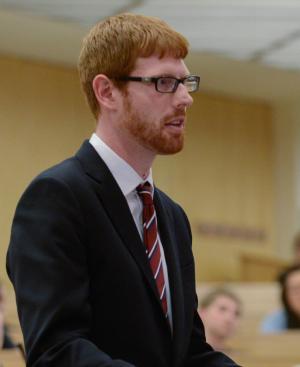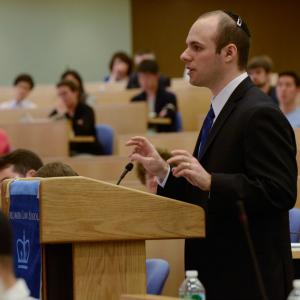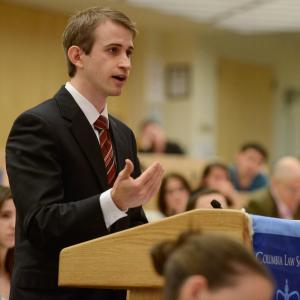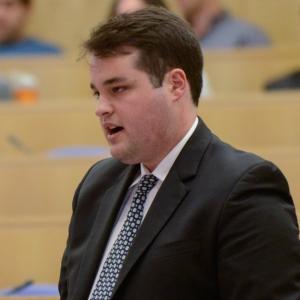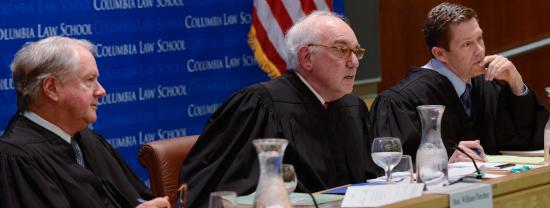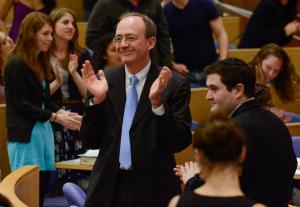William R. Sears '14 Awarded Best Oralist at Paul, Weiss Harlan Fiske Stone Moot Court Finals
Judges Praise All Four Competitors Including Sears, Best Brief Winner Joseph Itkis '14, Joseph Alm '13, and Daniel Straus '14
| William R. Sears '14 |
New York, April 19, 2013—Only one student—William R. Sears ’14—came away with the Lawrence S. Greenbaum Prize for best oralist at the Paul, Weiss Harlan Fiske Stone Moot Court Competition at Columbia Law School on April 8.
But one of the three distinguished judges overseeing the competition, U.S. Court of Appeals for the 6th Circuit Judge Jeffrey S. Sutton, was so impressed with the way all four competitors handled the complex arguments that he extended a standing invitation to each of them to argue cases in his court.
“Everybody always says you are just as good as the lawyers we see, but I’m going to prove it,” said Sutton, after the arguments were finished. “I’m going to give you a phone number to come in and argue at the 6th Circuit.”
The audience laughed, but Sutton wasn’t kidding—“Get out a pen,” he said, before rattling off the phone number of a person in the 6th Circuit clerk’s office.
“Say Judge Sutton sent you, and he will get you an argument,” he said. “So, hopefully I’ll see you again. You were terrific.”
Students, faculty members, and friends and family of the finalists packed into Jerome Greene Hall to see Sears and co-competitors Joseph J. Itkis ’14, Joseph C. Alm ’13, and Daniel D. Straus ’14 perform in the finals of the prestigious appellate advocacy competition, which is made possible by the generous support of Paul, Weiss, Rifkind, Wharton & Garrison.
| Joseph J. Itkis '14 | Joseph C. Alm '13 | Daniel D. Straus '14 |
The case the students argued, written by the competition’s student director, David P. Mattern ’13, involved timely questions about the constitutionality of the Dodd-Frank Act’s creation of the new Consumer Financial Protection Bureau and President Obama’s recess appointment of Richard Cordray as its director.
Itkis won the award for writing the best final-round brief.
Like Judge Sutton, the other members of the panel, Judge Robert D. Sack ’63 of the U.S. Court of Appeals for the 2nd Circuit who is also an adjunct professor at the Law School, and Judge William A. Fletcher of the U.S. Court of Appeals for the 9th Circuit, offered high praise for the finalists.
| Judges: (left) Hon. William A. Fletcher; Hon. Robert D. Sack '63; and Hon. Jeffrey S. Sutton |
“We should be so lucky as to have lawyers of your caliber arguing in front of us in the actual courtroom,” Fletcher said. “All four of you were very much in command of your material. It was impressive what you knew. This was an enormously difficult problem. I teach this stuff—what belongs where, the appointments clause, the recesses. It’s very hard.”
A similar real-world case reached a decision in January when the U.S. Court of Appeals for the D.C. Circuit ruled Obama’s appointment of Cordray was unconstitutional because it did not take place during a formal adjournment between sessions of Congress.
In the case argued at Columbia Law School, Sears and Itkis represented Blue Parrot Holdings Inc., a distressed financial company challenging the government’s power to liquidate it under the Dodd-Frank Act. Alm and Straus represented the Department of the Treasury, arguing that the powers granted to the Consumer Financial Protection Bureau and related agencies are constitutional and in the public’s interest.
The judges peppered the competitors with questions on everything from the definition of the word “recess” to whether the Senate can legally refuse to hold votes on presidential nominations.
“I was very impressed by how the finalists handled the problem,” said Mattern, who wrote the case over the summer after learning about the government’s liquidation authority in Professor Henry Paul Monaghan’s class last year.
| Professor Philip M. Genty |
Professor Philip M. Genty, the Everett B. Birch Innovative Teaching Clinical Professor in Professional Responsibility, who directs the Law School’s moot court program, said the finalists “were evenly matched in their understanding of the issues, level of preparation, and agility in fielding difficult questions from the bench."
“The great reward of directing this program is being able to collaborate with such a dedicated, talented group of students,” he said. “The finalists displayed very different personal styles, and it was impressive to see how well each of them had chosen a style that worked for him. I was also gratified that Judge Fletcher stressed the importance of brief-writing, suggesting that in the vast majority of cases it is the briefs rather than the oral presentations that determine the court’s decisions.”
Forty-five students entered this year’s three-round elimination competition, vying for the chance to present their arguments in the finals.
“I really enjoyed arguing in front of the court,” said Sears, the Lawrence S. Greenbaum prizewinner. “All of us put a lot of research into this. I knew my material. When they asked a question, I knew what answer I wanted to give.”
The Greenbaum Prize, established in 1951, is presented each year to the student who delivers the best oral presentation in the Harlan Fiske Stone finals.
Members of the 2013 moot court executive committee are: Mattern, director, Harlan Fiske Stone Honors Moot Court; Debra Aboodi ’13, executive director, Moot Court Program; Thomas Kessler ’13, director, First-Year Moot Court Program; Mia Lee ’13, website coordinator; and Jason Georges ’13, teaching fellow, Specialized Programs.
| (left to right) Thomas Kessler, Joseph Itkis, Philip Genty, William Fletcher, William Sears, Debra Aboodi, Robert Sack, Joseph Alm, Daniel Staus, David Mattern, and Jeffrey Sutton |
This year marked the 88th anniversary of the Stone Moot Court, which was founded in 1925. The competition is named in honor of Harlan Fiske Stone, who was dean of the Law School from 1910 until 1924 when President Calvin Coolidge appointed him attorney general of the United States. Stone was named to the U.S. Supreme Court the following year and was elevated to chief justice in 1941.
